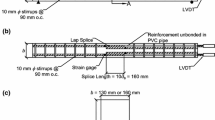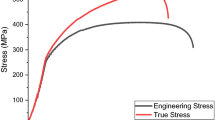Abstract
Surface mounted strain gages are used to characterize the behavior of polymer-enhanced cementitious beams designed to withstand reverse loadings. These unique composite structures are doubly reinforced with hollow carbon fiber (graphite) tendons equipped with strain gages and the study includes section design, materials considerations, structural testing, and finite element analysis. The primary purpose of strain gage integration is to insure that the stress in the materials remains within the elastic range so that damage does not occur. A finite element model is developed to characterize the structural response in the elastic range and a hybrid approach is suggested in which displacement, strain, and stress can be obtained with a single strain gage. The ability to characterize structural performance beyond the elastic range is also demonstrated by analyzing data obtained from displacement-controlled tests.



















Similar content being viewed by others
References
Hexcel Corporation (2005) Prepreg technology, publication no. FGU 017b, March; online at: http://www.hexcel.com/Resources/DataSheets/Brochure-Data-Sheets/Prepreg_Technology.pdf
U.S. Department of Defense (2002) Composite materials handbook, volume 2: polymer matrix composites materials properties, MIL-HDBK-17-2 F, June 17, pp. 4-41 and 4-63
Teng J (2001) FRP composites in civil engineering, volumes 1–2, Elsevier. ISBN 978-0-0804-3945-7
Biszick KR, Toutanji HA, Gilbert JA, Marotta SA, Ooi TK (2006) Evolution of strategically tuned absolutely resilient structures (STARS). Proc. of SEM Annual Conference & Exposition on Experimental and Applied Mechanics, Saint Louis, Missouri, Paper No. 32, 7 pages
Biszick KR, Gilbert JA (1999) Designing thin-walled, reinforced concrete panels for reverse bending. Proc. of the SEM Spring Conference on Theoretical, Experimental and Computational Mechanics, Cincinnati, Ohio, pp. 431- 434
Vaughan RE, Gilbert JA (2001) Analysis of graphite reinforced cementitious composites. Proc. of the SEM Annual Conference and Exposition, Portland, Oregon, pp. 532–535
Ooi TK, Gilbert JA, Bower MV, Vaughan RE, Engberg RC (2005) Modal analysis of lightweight graphite reinforced silica/polymer matrix composite plates. Exp Mech 45(3):1–5
Ooi TK, Engberg RC, Gilbert JA, Vaughan RE, Bower MV (2004) Modal testing of a lightweight cementitious structure. Experimental Techniques, November/December, pp. 37–40
Badr A, Ashour AF, Platten AK (2006) Statistical variations in impact resistance of polypropylene fibre-reinforced concrete. Int J Impact Eng 32(11):1907–1920
Binek LA, Gilbert JA, Ooi TK, Bower MV, Biszick KR (2007) Ballistic testing of STARS. Proc. of SEM Annual Conference & Exposition on Experimental and Applied Mechanics, Springfield, Massachusetts, Paper No. 196, 10 pages
Xu B, Toutanji H, Gilbert JA (2010) Impact resistance of poly(vinyl alcohol) fiber reinforced high-performance organic aggregate cementitious material. Cement Concr Res 40:347–351
Lavin T, Toutanji H, Xu B, Ooi TK, Biszick KR, Gilbert JA (2008) Matrix design for strategically tuned absolutely resilient structures (STARS). Proc. of SEM XI International Congress on Experimental and Applied Mechanics, Orlando, Florida, Paper No. 71, 12 pages
Toutanji H, Xu B, Gilbert JA, Lavin T (2010) Properties of poly(vinyl alcohol) fiber reinforced high-performance organic aggregate cementitious material: converting brittle to plastic. Construct Build Mater 24(1):1–10
Xu B, Toutanji HA, Lavin T, Gilbert JA (2011) Characterization of poly(vinyl alcohol) fiber reinforced organic aggregate cementitious materials. Polym Concr 666:73–83
RockTest Limited, Saint-Lambert, Quebec, Canada (2005) Instrumented rebar and sister bar, Model IRHP and IRCL. Data sheet available on the web at: http://www.roctest-group.com/sites/default/files/datasheets/products/IRHP-E50138-W_0.pdf, pp. 1–2
Encardio-rite Electronics, Lucknow, India (2008) Model EDS-12 V vibrating wire sister bar strain meter. Product sheet available on the web at: http://www.encardio.com/consolidated2011-12_eng.pdf, p. 15
Sanchez J, Andrade C, Fullea J (2010) Hydrothermal monitoring using embedded sensors of the actual roof system of the Prado museum. Construct Build Mater 24(12):2579–2589
Bommu RK (2010) Development of instrumented tendons for embedment in a structural information system. Master’s Thesis, Department of Mechanical and Aerospace Engineering, University of Alabama in Huntsville
Biszick KR (2010) Design of a structural information system (SIS) for strategically tuned absolutely resilient structures (STARS). Ph.D. Dissertation, Department of Civil and Environmental Engineering, University of Alabama in Huntsville
Biszick KR, Gilbert JA, Toutanji H, Lavin T, Britz MT, Bommu RK (2011) Characterization of adaptive reinforced concrete structures, Proc. of SEM Annual Conference & Exposition on Experimental and Applied Mechanics, Uncasville, Connecticut, Paper No. 124, 12 pages
Wootton IA, Spainhour LK, Yazdani N (2003) Corrosion of steel reinforcement in carbon fiber-reinforced polymer wrapped concrete cylinders. J Compos Construct 7(4):339–347
U.S. Department of Defense (2002) Composite materials handbook, volume 2: Polymer matrix composites materials properties, MIL-HDBK-17-2 F, June 17, pp. 4–110 – 4–116
Benenson W, Harris JW, Stocker H, Lutz H (2002) Handbook of physics. SPRINGER, New York, pp 233–241
ASTM C78/C78M-10 (2010) Standard test method for flexural strength of concrete (using simple beam with third-point loading). Available on the web at: http://www.astm.org/Standards/C78.htm
Hexcel Corporation, 3501-6 Epoxy matrix product data sheet, Pleasanton, CA. Available on the web at: http://www.hexcel.com/Resources/DataSheets/Prepreg-Data-Sheets/3501-6_eu.pdf
Talreja R, Yalvac S, Yates LD, Wetters DG (1992) Transverse cracking and stiffness reduction in cross ply laminates of different matrix toughness. J Compos Mater 26:1647
Lindell M (2006) The laminator - classical analysis of composite laminates. Version 3.6 program shareware available on the web at: http://www.thelaminator.net
ASTM C150/C150M-11 (2011) Standard specification for Portland cement. Available on the web at: http://www.astm.org/Standards/C150.htm
ASTM C618-08A (2008) Standard specification for coal fly ash and raw or calcined natural pozzolan for use in concrete. Available on the web at: http://www.astm.org/Standards/C618.htm
Mark JE (1999) Polymer data handbook. Oxford University Press, Inc., pp. 910-912
ASTM C494/C494M-11 (2011) Standard specification for chemical admixtures for concrete. Available on the web at: http://www.astm.org/Standards/C494.htm
Sika® ViscoCrete® 2100: High range water reducing admixture: Product data sheet identification no. 781-540 (2005), Sika Corporation, Lyndhurst, New Jersey, pp. 1–2. Available on the web at: http://us01.webdms.sika.com/fileshow.do?documentID=52
ASTM D747-10 (2010) Standard test method for apparent bending modulus of plastic by means of a cantilever beam. Available on the web at: http://www.astm.org/Standards/C494.htm
ASTM C39/C39M-12 (2012) Standard test method for compressive strength of cylindrical concrete specimens. Available on the web at: http://www.astm.org/Standards/C494.htm
On Hand Adhesives, Inc. (2012) Hysol 9430. Available on the web at: http://www.gluguru.com/Hysol%20Data%20Sheets/9430.htm
Acknowledgments
The authors would like to thank the United States Army Research, Development, and Engineering Center (AMRDEC) of the Research, Development, and Engineering Command (RDECOM) at Redstone Arsenal in Huntsville, Alabama, for supporting this research under the Department of Defense (DOD) SBIR Contract No. W31P4Q-05-C-R103. Portions of the study were also funded by the U.S. Department of Commerce under NOAA SBIR Contract No. WC133R-09-CN-0108. The authors would also like to thank Mr. Ravi K. Bommu for his work involving tendon development, Drs. Thomas Lavin and Bo Xu for their contributions to concrete development, and Mr. Rajesh Vuddandam for his contribution to beam testing with the data acquisition system. Any opinions, findings, conclusions or recommendations expressed in this publication are those of the authors and do not necessarily reflect the views of the funding agencies previously mentioned.
Author information
Authors and Affiliations
Corresponding author
Rights and permissions
About this article
Cite this article
Biszick, K.R., Gilbert, J.A., Toutanji, H.A. et al. Doubly Reinforcing Cementitious Beams with Instrumented Hollow Carbon Fiber Tendons. Exp Mech 53, 579–592 (2013). https://doi.org/10.1007/s11340-012-9665-6
Received:
Accepted:
Published:
Issue Date:
DOI: https://doi.org/10.1007/s11340-012-9665-6




